Are Mexico, El Salvador, and Honduras Under Insurgent Attack?
Stephen B. Young
Failure of national authorities in Mexico, El Salvador, and Honduras pose risks to the well-being of the United States. First, state failure in El Salvador and Honduras creates migrant flows seeking refuge in the United States as a safe-haven for families. Second, state failure in each of these countries could grow into complete collapse of state authority and the rise to power of authoritarian regimes such as in Cuba and Venezuela which will collaborate with geo-political rivals of the United States in contravention of the Monroe Doctrine. Third, instability of social orders, economics, and politics in the countries immediately to our south will decrease regional progress towards higher living standards, undermining quality of life in our part of the world.
The Wall Street Journal of Dec 26 carried a story from Mexico on the rise in murders and kidnappings. That paper on Dec 24 had already published a story that gangs in Mexico run a parallel government as an extortion economy. In 2017 there were 6.6 million cases of extortion of individuals and 525,000 cases of extortion against companies.
The Journal on Dec 19 carried a story that, in El Salvador, when 17-year-old Andrea Guzman refused advances from a gang leader, “he responded by dispatching seven underlings dressed in black to the two-room house she shared with her family in this hamlet amid corn and bean fields. They tied up her parents and older brother, covered Andrea’s mouth and forcibly led her out into the night in her flip-flops. Hours later, one of her abductors fired a shot into her forehead in a field nearby.”
But we don’t call conditions in Mexico, El Salvador, and Honduras “insurgencies”. Therein lies a major failure in our thinking about world events and their claim to our attention for protecting a global order favorable to our way of life and future prosperity.
The Latin roots of our word “insurgency” come from the prefix “sub” or below and the verb “regere” or manage or guide. The root of “insurgency” means to lead from below, or to rise up against superior authority. “Regere” evolved from the Into-European root stem “reg” which indicated movement in a straight line. From the stem “reg” also derived the Latin word “rex” or king and the English words “royal”, “realm”, “right”, “rectify”, “correct”, and “to direct”.
In the Oxford English Dictionary, early uses of the word “insurgency” were:
1765 FALCONER Demagogue 377 “His sanction will dismay, And bid th' insurgents tremble and obey.”
1801 WELLINGTON Mem. Seringapatam in Gurw. Desp. (1837) I. 348 “In regard to the insurgents in Malabar, the war against them cannot be carried on at all without assistance.”
1812 G. CHALMERS Dom. Econ. Gt. Brit. 164 “[Why] it was, that the vast strength of Britain did not beat down the colonial insurgents, not in one campaign, but in three.”
1851 GALLENGA Italy 133 “He acceded to all the immediate demands of the insurgents”.
Underneath our word “insurgency” then is concern for the human phenomenon of governance: who will lead us in a straight line, properly, so that we will be correct? But the term insurgency points to governance from the bottom up, not from the top down. The problem of insurgency correctly understood is how does higher authority actually provide effective governance at subordinate levels of society and culture? In other words, counter insurgency is the challenge of acquiescing to subsidiarity in decision-making while insuring that those holding decentralized power are in alignment on high priority goals and behaviors with the norms and practices legitimated by higher authority.
Accordingly, we should adjust our theories of insurgency and its counter-measure – counter-insurgency away from strictly military interventions using forces and coercion towards understanding which embrace politics, local leadership, community building, and other mechanisms promoting social order.
Thus, brigandage, gangs, and mafia networks as well as political movements seeking to overthrow and replace a governing regime can be sources of insurgency. Each in its own way provides “management” of people from below in defiance of national authorities.
Our Department of Defense definition of insurgency as “An organized movement aimed at the overthrow of a constituted government through use of subversion and armed conflict" Is too narrow. Any attempt to disrupt the central government by means considered illegal by that government should be considered an insurgency.
The United States can better protect its interests in Mexico and Central America where gang-based insurgencies thrive and deny citizens the benefits of good government once it redefines those dysfunctional communities as under insurgent attack. It then remains for the United States to counter such insurgences with cost-effective strategies and tactics.
Consider the case of Mexico. From 2007 to 2014, 164,000 Mexicans died violently, more than the 103,000 civilians killed in Iraq and Afghanistan during those years. In 2016 Mexico surpassed Iraq and Afghanistan to become, after Syria, the world’s second deadliest war zone, according to the Annual Armed Conflict Survey of the International Institute for Strategic Studies.
In 2016 there were more than 50,000 lives lost in Syria, 23,000 in Mexico, 17,000 in Afghanistan and 16,000 in Iraq. IISS director general John Chipman said ““Mexico is a conflict marked by the absence of artillery, tanks or combat aviation.” Deaths were caused by small arms. The largest number of fatalities occurred in Mexican states that have become “key battlegrounds for control between competing, increasingly fragmented cartels,” Chipman said, with violence flaring as gangs try to clear areas of rivals so they can monopolize drug trafficking routes.
In 2017 some 31,174 persons lost their lives in Mexico More were taken away and their fate not yet known.
El Salvador has the world’s highest homicide rate. The MS-13 gang operates in 248 of the country’s 262 municipalities. In the capital San Salvador, gangs control the local distribution of consumer products, including diapers and Coca-Cola. They extort commuters, call-center employees, restaurant and store owners. In rural villages, gangs threated to burn sugar fields unless the farmers pay up.
Gang violence, a form of war-lord-ism, negates public authority and reduces citizens to a state of nature along the lines described by political philosopher Thomas Hobbes: “the life of man is solitary, poor, nasty, brutish and short.” Those circumstances certainly apply to war, declared or un-declared, conventional or limited. They apply to most of Syria today, to Iraq during the years of sectarian conflict, and today to large parts of Afghanistan. Hobbesian realities also happen in cases where government fails to meet its basic police responsibilities; provide quality of social life, security of persons and property, and economic well-being.
Mexico is not alone in facing collapse of government in many local communities El Salvador and Honduras have exceptionally high murder rates as well, concentrated in some localities. Gangs in all three countries are more dominant than government police forces in the lives of many citizens. When some 8 years ago Mexico sent its armed forces to suppress drug cartels, the cartels defeated them to maintain control of many communities.
The gangs function as states within the national state, which is such a state in name only. Gang control of people and territory follows Mao’s dictum that “political power flows from the barrel of a gun.”
We also know that in Afghanistan criminality in the drug trade contributes to the efficacy of the Taliban, blurring any sharp distinction between crime and sectarian dedication. For both Mexican drug cartels and Taliban insurgents, community control for recruitment and sabotage of government deployments of the military, policy, education, economic development, is a common strategic objective.
To defeat either the drug cartels or the Taliban, converting the rural people into front line counterinsurgents is necessary for government success in the struggle for power.
In El Salvador the civil war of the 1980s, a classic ideological insurgency to overthrow a traditional ruling elite, was not won by the government. No counterinsurgency program was brought to the field. Our military advisors worked with the El Salvadoran government on an attrition strategy. The will of the guerillas to fight on just outlasted the Americans and their local partners. Rural villages had 40% unemployment for young men, providing the insurgents with all the recruits they needed to defeat an attrition strategy. Finally, a political compromise was reached. It left the national government weak and inefficient. Gangs then stepped into the power vacuum at local levels in effect sustaining conditions of insurgency under another name.
El Salvador’s gangs earn about $20 million a year from extortion, including $3 million from businesses in the history center of San Salvador, the Capital. The two gangs MS-!3 and Barrio 18 hire 60,000 people as lookouts, collectors, and assassins. In2016 the Central Bank estimated the economic cost of this “insurgency” to be $4 billion a year, or 16% of GDP. El Salvador’s Minister of Justice and Security says, “you don’t know where the state ends and the criminal organizations begin.”
As in political insurgencies, gangs function as mini-police forces and routine local governments. They form social authorities fragmented and dispersed among the population using their power for private purposes. Their effect is to deny the people ordinary and salutary public governance under some legitimate rule of law. Gang based insurgency compromises government not so much by using violence to impose a political program but with corruption to divert government officials from their duties. Gang based insurgencies are more a persistent low-level infection than a mortal, metastasizing cancer. But they can destroy civil order and public happiness just the same.
Gangs in El Salvador, Guatemala and Honduras now profit from extorting their neighborhoods, not selling drugs to foreigners. They are in effect collecting taxes based on their control of violence.
As gang-engendered violence proliferates, the middle and upper classes hire protection. In every central American country private security forces outnumber the police, further fragmenting the power to establish good government for the society.
Politicians choose to work with groups having a mastery of violence in local communities, giving them immunity in exchange for bribes, campaign contributions, assistance in suppressing opposition voters. Corrupt security forces tend to turn criminal. The only law is that of the gun.
The Gene Pitney song “the Man who Shot Liberty Valance” brings forth the reality:
When Liberty Valance rode to town
The women folk would hide, they'd hide
When Liberty Valance walked around
The men would step asideBecause the point of a gun
Was the only law that Liberty understood
When it came to shootin' straight and fast
He was mighty goodFrom out of the East a stranger came
A law book in his hand, a man
The kind of a man the West would need
To tame a troubled land'Cause the point of a gun
Was the only law that Liberty understood
When it came to shootin' straight and fast
He was mighty goodMany a man would face his gun and many a man would fall
The man who shot Liberty Valance
He shot Liberty Valance
He was the bravest of them all
Let us consider some maps to see the correspondence between insurgent wars and gang-based insurgency:
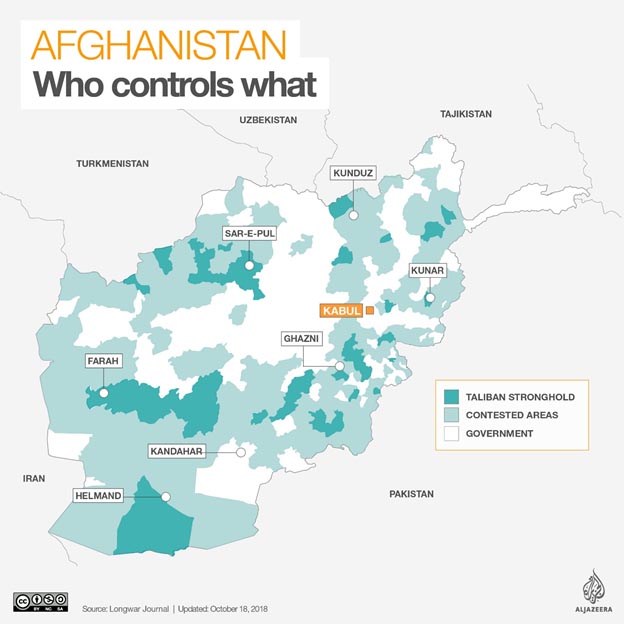
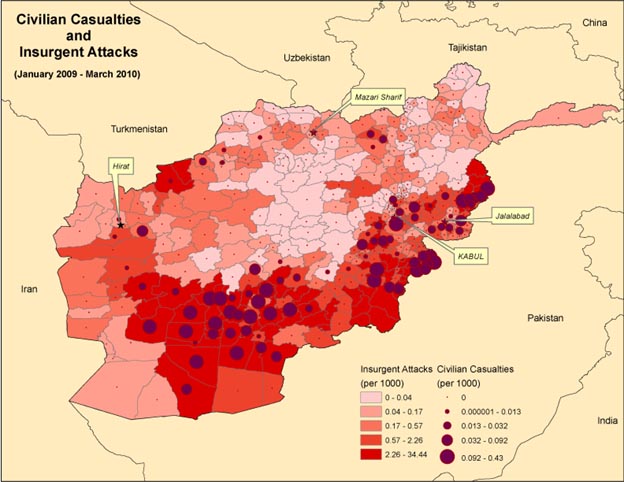
Afghanistan: Who Controlled What – 2009-2010
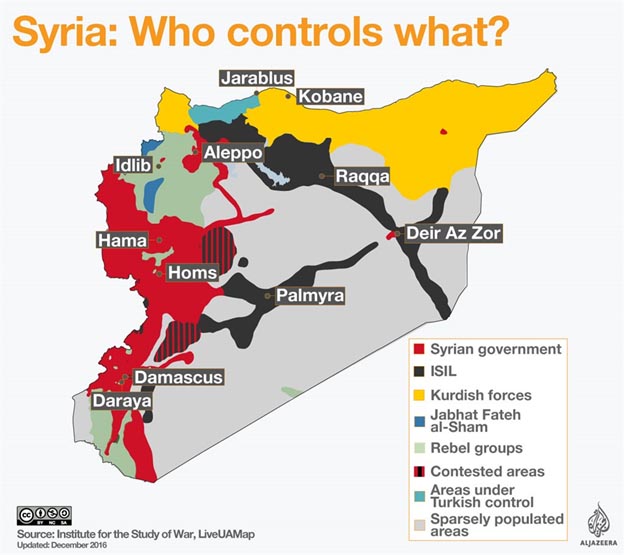
Syria: Who Controlled What – December 2016
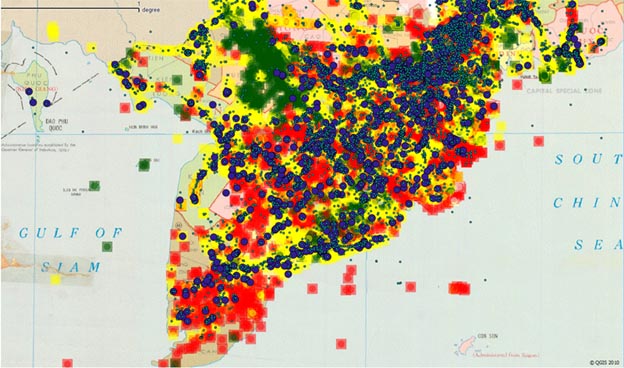
South Vietnam: Who Controlled What
Government control and violence against civilians in third and fourth corps in South Vietnam. Green means full government control, yellow means mixed control, and red means full rebel control. Large dots indicate government officials assassinated, and small dots indicate citizen assassinated.
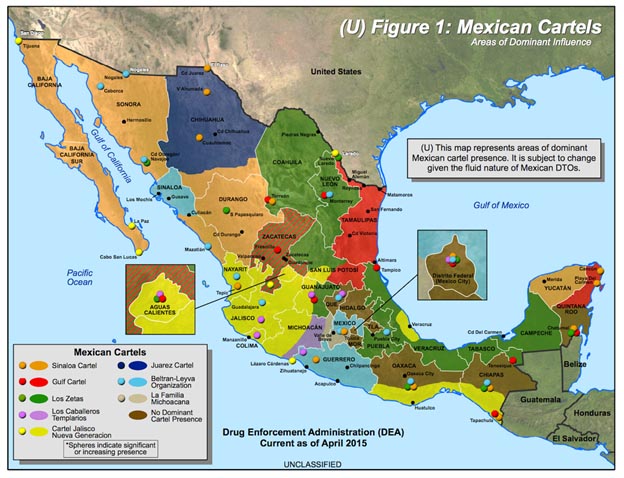
Mexico: Who Controlled What – 2015
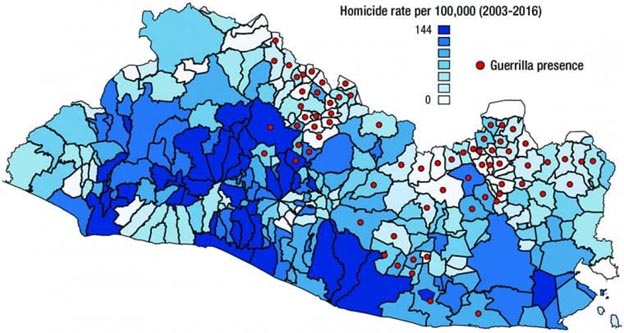
El Salvador: Who Controlled What – 2003-2016
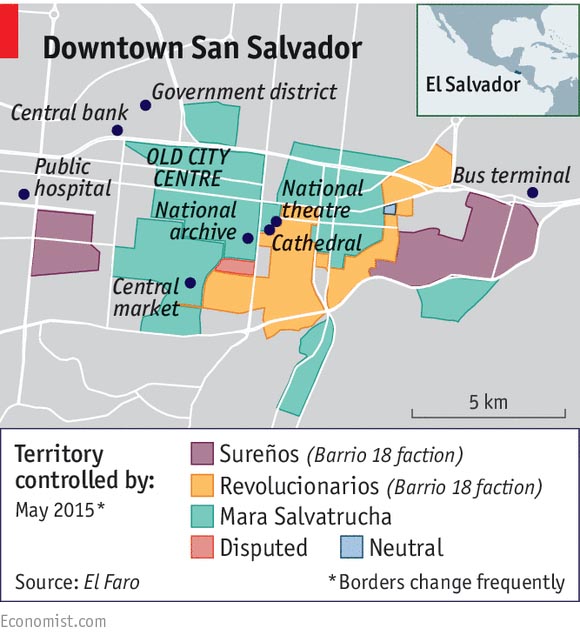
San Salvador: Who Controlled What – May 2015

Honduras: Who Controlled What
Since 2008, the United States Congress has appropriated over $1 billion to help Central American governments strengthen state institutions, build functional police forces, and take back neighborhoods held by gangs and organized criminals. But there has been no application by our partners of best counterinsurgency practices. No clear, hold and build. No COIN.
Recommendation: Adopt a CORDS Program to Establish Civic Order in Bang-based Insurgencies
CORDS (Civil Operations Rural Development Support) was the unique US civil/military program which partnered with Vietnamese nationalists at village, district, province, region, and national levels to mobilize the people of South Vietnam to defeat the Viet Cong by 1972 starting in 1967.
The strategy of CORDS was to fight a people’s war against communist led insurgents. The tactics of CORDS were to consider the people as the frontline fighters against the insurgents and to support them with decentralized governing authority, self-defense, and self-development programs. The self-interest of rural communities coupled with anti-communist family and personal values were promoted to mobilize the people.
A gang-based mafia or mini-warlord insurgency has its own characteristics which distinguish its strategy and tactics from political/ideological insurgencies. The gang-based insurgency does not seek to become an official ruling authority. It does not want to be a government. It is more a private collaboration seeking money and power in local communities. In some ways a gang-based insurgency resembles a terrorist network.
A gang-based insurgency focuses on terror and intimidation without recruiting any mass political following. It does not have political cadres, only armed terrorists. It does not seek to inspire the people, only to intimidate them and so subject them in support of criminal activity.
When dealing with defeat of a gang-based insurgency, we must distinguish the CORDS approach from the COIN approach. Under COIN principal responsibility for success lies with either foreign forces or forces of the central government. The strategic objective of COIN is to protect the people. Neither foreign forces nor host government forces are capable of providing sufficient protection of the people in gang-based insurgencies.
Unlike COIN approaches and small unit tactics designed for low-intensity armed conflicts, the CORDS strategy for defeating insurgencies puts governance of the local community at the center of the anti-insurgent campaign.
In cases of gang-based insurgency, foreign forces will not be available other than in advisory and support capacities and foreign support is most likely to be civilian – police, economic development and social capital enhancement. And, central government deployments (police, army, civil officials) will be ineffective or even sustaining of the insurgents due to corruption and insurgent intimidation.
In the CORDS approach, the people are to be the principal source of their own protection, supported by government assets in finding, fixing, fighting, and finishing insurgent cadres to reduce the threat nearby and inside local communities, coming to the immediate assistance of local self-defense teams, gathering necessary intelligence and acting on it promptly, and providing public services.
The best practices of counterinsurgency under the CORDS approach are:
- Arm the people
- Provide them with effective local government
- Give them hope for better lives under their own control
- Eliminate the insurgents by gathering correct, timely intelligence, arrest, and apprehension
- Pardon those who abandon gang life and employ them productively
In Mexico and Central America, cultural factors drive gang-based insurgencies. These powerful psycho-social dynamics must be, first, offset, and, second, overcome by countervailing psycho-social dynamics. Fear of the government created by violent repression is most often insufficient to offset cultural aspirations of having personal power, easy money, and being respected by the community for having a certain kind of personal charisma.
In Mexico and Central America, there is a cultural residue of the conquistador life-style where machismo and personal dominance are valued. The Spanish conquistadors used force and violence to become the protecting patron, a “Don” so to speak, having clients who depended on him as “Jefe” or Chief of the social unit for security and economic well-being. The system was named the encomienda society. Under Spanish rule, a Spanish encomendero was granted a number of native laborers who would pay tributes to him in exchange for his protection. In Mexico after the revolution the system took the form of haciendas or, today, patron/client networks.
From a sociological perspective, gangs today in Mexico and Central America simply carry on illegally the rudiments of this encomienda system of local over-lordship taking care of loyal clients.
In Mexico, El Salvador, and Honduras where businesses and the more well-to-do employ their own security guards, such private security forces can be converted into local militias with powers of arrest along the lines of an authorized posse comitatus.
In Common Law, the posse comitatus is all able-bodied males over the age of 15 within a specific county, when mobilized in whole or in part by the conservator of peace – usually the sheriff – to suppress lawlessness or defend the county. The posse comitatus originated in ninth century England simultaneous with the creation of the office of sheriff. Though generally obsolete throughout the world, it remains theoretically, and sometimes practically, part of the United States legal system. In Minnesota where I live, this reserve security force is, under statute, the “unorganized militia”.
Minnesota Statues, Chapter 191.05, provides that:
GOVERNOR MAY CALL MILITIA. Whenever the governor deems it necessary for any purpose authorized by the state constitution or by law, may by public proclamation call out the militia or such part or number thereof as the governor may designate for military duty in the service of the state, and may provide for the enrollment, assembly, and muster into service by voluntary enlistment or by draft, as the governor may determine, of the militia so called out. For that purpose, the governor may make orders and rules and enforce the same, appoint all necessary officers and fix their compensation, and may require all proper public officers to perform such duties as the governor may direct.
Second, In El Salvador and Honduras where gang-based insurgents have adopted a “uniform” of body tattoos to distinguish members of the insurgent force from civilians, the uniform cannot be easily removed when an insurgent seeks to relinquish membership in the gang. Thus, some novel device must be found to give those who have defected from the insurgency and seek to resume the status of a citizen in good standing to be recognized, appreciated and protected.
One possible approach would be to form and fund a national patriotic or social movement for better lives. This movement would have local chapters, sports and educational programs for youth, skill and craft markets for women, continuing education for adults, cultural festivals. The middle class, civil society organizations, religions would be recruited to participate in and lead such organized activities. The insurgents would be bit by bit socially and culturally alienated from the mass of the population. Their ability to attract clients would atrophy and the insurgency, in classic fashion, would evaporate.
The principal challenges to successful application of a CORDS approach to gang-based insurgency in Mexico and Central America are: corrupt police forces; failure of national elites to institutionalize rational/legal institutions at the national and provincial levels; military cultures incapable of engaging with local communities in partnerships by intuitively acting as conquistador; politicians who seek only to reward their clients and have little sense of the common good.
